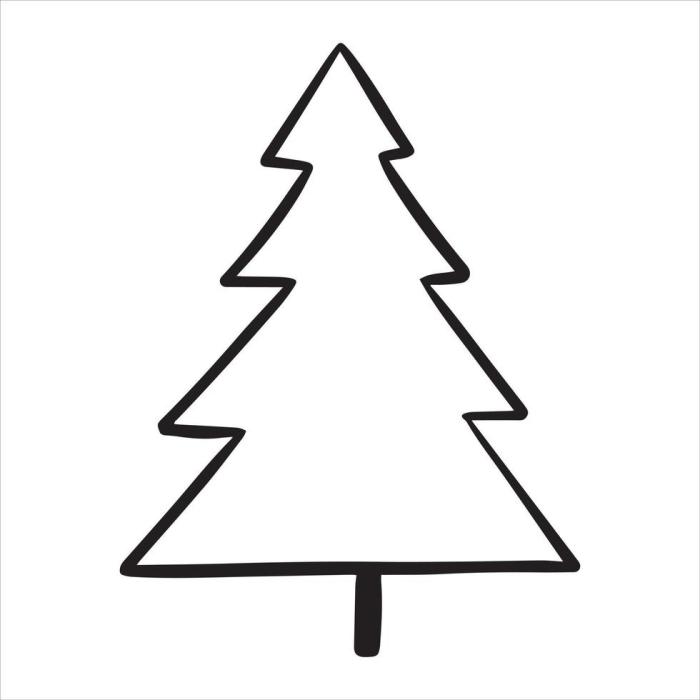Simple Christmas Tree Designs

Christmas tree easy drawing – Let’s face it, not everyone is blessed with the artistic skills of Michelangelo (or even Bob Ross, for that matter). But fear not, aspiring artists! Creating a charming Christmas tree drawing is entirely achievable, even if your artistic talents currently reside somewhere between a toddler’s scribble and a particularly abstract Jackson Pollock. This guide will arm you with the simple techniques to create festive masterpieces that will impress your family, friends, or even just your cat.
Three Simple Christmas Tree Styles
We’ll explore three distinct approaches to drawing a Christmas tree, each perfect for beginners. These styles range from minimalist chic to gloriously cartoonish, guaranteeing a design to match your personal aesthetic (or lack thereof). Think of it as a Christmas tree design buffet – something for everyone!
Mastering a Christmas tree easy drawing is all about simplifying shapes. Beginners often find the symmetrical structure surprisingly accessible. For a more nuanced approach, consider incorporating elements from nature, such as the delicate lines found in a a chaste branch easy drawing , to add realism to your Christmas tree’s branches. This detail elevates a simple drawing into something more evocative, enhancing the overall festive feel of your artwork.
Drawing a Minimalist Christmas Tree
This approach embraces simplicity. Forget intricate details; we’re going for pure, unadulterated geometric elegance.
- Step 1: The Triangle of Triumph: Start by drawing a simple, slightly uneven triangle. Think of it as the basic shape of your tree. It doesn’t have to be perfect; a little wonkiness adds character (or so we tell ourselves).
- Step 2: The Trunk of Truth: Add a thin, brown rectangle underneath the triangle for the trunk. This is the foundation of your arboreal masterpiece. Remember, less is more!
- Step 3: The Star of Simplicity (Optional): To top it off, draw a small star at the peak of your triangle. You can make it five-pointed, or even go for a more modern, abstract star design. Keep it simple!
And there you have it! A minimalist Christmas tree that screams sophistication without demanding a PhD in art.
Drawing a Cartoonish Christmas Tree
Let’s unleash our inner child and create a Christmas tree that’s bursting with personality. This style embraces exaggeration and fun!
- Step 1: The Wobbly Wonder: Draw a wide, uneven triangle, but this time, make it really, ridiculously wobbly. Think of a tree that’s had a bit too much eggnog.
- Step 2: The Stubby Stump: Add a short, fat brown rectangle for the trunk – it should look almost comical in its disproportionate size compared to the treetop.
- Step 3: The Giggle-Inducing Ornaments: Add oversized, simplistic ornaments. Think circles, squares, even smiley faces. The more chaotic, the better!
- Step 4: The Wacky Star: Top it off with a wildly disproportionate star – perhaps a star with wonky points or even a star shaped like a pretzel.
Behold! A Christmas tree so wonderfully bizarre, it’s guaranteed to elicit giggles.
Incorporating Simple Decorative Elements, Christmas tree easy drawing
Even the simplest Christmas tree design can benefit from a little festive flair. Adding simple decorative elements is a great way to personalize your creation and add that extra touch of holiday cheer.Adding stars, simple circles for ornaments, or even zig-zag lines to suggest tinsel is surprisingly easy. Don’t be afraid to experiment with different colors and patterns! Remember, it’s your tree; let your creativity run wild (within the bounds of simple shapes, of course).
A few strategically placed dots can even represent lights!
Adding Detail and Texture

So, you’ve drawn a simple Christmas tree. Congratulations, you magnificent artist! But let’s be honest, it looks a little…sad. Like a lonely twig contemplating the meaning of life in a particularly bleak December. Let’s add some pizzazz, someoomph*, some serious textural delight! We’re going to transform that stick figure into a festive masterpiece worthy of gracing the cover of a Christmas card (or at least your fridge).Adding detail and texture to your Christmas tree drawing is all about creating the illusion of three-dimensionality and visual interest.
Think of it as giving your tree a personality – a fluffy, sparkly, slightly chaotic personality, just like a real Christmas tree. We’ll explore several techniques to achieve this, from subtle shading to elaborate needle work (well, drawing needle work).
Techniques for Creating Texture
We can use various techniques to simulate the texture of a pine tree. One simple method is employing different line weights and densities. For example, thicker, darker lines can represent denser areas of needles, while thinner, lighter lines can represent sparser areas. Shading, using a range of tones from light to dark, can also create the illusion of depth and texture.
Imagine a spotlight shining on your tree – the areas facing the light will be brighter, while the areas facing away will be darker. Experiment with cross-hatching (overlapping lines) and stippling (tiny dots) to create a variety of textures. Think of it like painting with lines and shadows instead of paint. A simple gradient from dark at the base to lighter at the top can already make a big difference.
Adding Depth with Shading and Highlighting
Shading is your secret weapon for creating a three-dimensional Christmas tree. Start by identifying your light source. Is it a spotlight from above? A gentle glow from a fireplace? Once you know where the light is coming from, you can strategically place your highlights (bright areas) and shadows (dark areas).
The side of the tree facing the light will be lighter, while the opposite side will be darker, creating a sense of depth and volume. Remember, even the most perfectly conical Christmas tree has subtle curves and variations in light and shadow. Don’t be afraid to experiment!
Drawing Pine Needles
Drawing realistic pine needles can be challenging, but even a simplified representation can greatly enhance your drawing. For a realistic look, try drawing small, needle-like shapes clustered together. You can vary the length and direction of the needles to create a more natural look. For a simpler approach, use small, short lines or dots to suggest the texture of the needles.
Think of it as a stylized representation; you’re not trying to recreate a botanical illustration, but rather capture the essence of pine needles. Even simple clusters of short, slightly uneven lines can look convincingly “needly”.
Drawing and Hanging Ornaments
Now for the fun part – decorating! Let’s add some ornaments. Start with simple shapes: circles for baubles, elongated shapes for candy canes, and stars for…well, stars. You can add details like stripes, dots, or glitter effects using simple lines and shading. To hang them, draw thin lines connecting the ornaments to the branches. You can create the illusion of depth by slightly overlapping the ornaments or making some appear further away than others.
Consider using different sizes and shapes of ornaments to add visual interest – think about creating a pattern or a random mix. Perhaps a few perfectly round baubles next to a wonky homemade ornament will bring a sense of charming imperfection to your creation. Let your creativity run wild!
Step-by-Step Tutorial: Christmas Tree Easy Drawing

So you want to draw a Christmas tree? Excellent! Prepare yourself for a journey into the wonderfully wobbly world of artistic expression. Don’t worry if your tree looks more like a slightly lopsided pine cone at first – we all start somewhere (usually with a very wonky triangle).
This section provides a simple, step-by-step guide to drawing a basic Christmas tree, followed by a visual guide to spiffing it up with decorations and a festive backdrop. Think of it as a Christmas tree drawing boot camp – expect some serious artistic sweat (but mostly just fun).
Simple Christmas Tree Drawing
Let’s start with the basics. This step-by-step guide will have you crafting a charmingly simple Christmas tree in no time. Even if your artistic skills are as sharp as a slightly blunt butter knife, you can conquer this.
- Step 1: The Foundation Draw an upside-down triangle. Think of it as the tree’s sturdy, slightly grumpy, foundation. Don’t worry about perfection; embrace the wonkiness!
- Step 2: Branching Out Add slightly curved lines on either side of the central triangle, connecting to the base. These are your main branches – think of them as the tree’s happy, slightly less grumpy arms.
- Step 3: Fluffy Branches Add smaller, slightly less curved lines inside the larger branches to create a fuller, fluffier look. This is where your artistic flair truly shines (or, at the very least, where you can hide any imperfections).
- Step 4: The Trunk Draw a simple, slightly irregular rectangle at the bottom of the triangle. This is the tree’s stoic, incredibly grumpy trunk.
- Step 5: Festive Finish Add a star or a simple circle at the top of the triangle for the finishing touch. Your tree is now officially festive and ready to be admired (or at least chuckled at).
Adding Decorations and Background Elements
Now, let’s turn that simple tree into a festive masterpiece! This visual guide will walk you through adding delightful decorations and a charming background. Prepare for some serious artistic pizzazz.
- Decorations: Imagine a perfectly symmetrical, perfectly spaced arrangement of ornaments. Then, throw that idea out the window! Scatter some circles (ornaments) of varying sizes across the tree in a haphazard, joyful fashion. Add some squiggly lines to represent tinsel. Let your imagination run wild!
- Background: A simple, wavy line at the bottom represents the ground. Add some more wavy lines or simple shapes to suggest snow drifts. For a truly festive touch, consider adding a crescent moon and some twinkling stars in the sky. Think about a charming, slightly crooked snowman for added festivity.
- Additional Touches: A slightly wonky gift box under the tree adds to the festive charm. Maybe a friendly-looking reindeer peeking from behind the tree for a playful touch. Don’t be afraid to experiment with different colors and patterns to make your tree uniquely you.
FAQ Overview
What materials do I need to draw a Christmas tree?
You’ll primarily need paper, a pencil, and an eraser. Colored pencils, crayons, or paints can add extra festive flair!
How long does it take to draw a simple Christmas tree?
A simple design can be completed in 15-30 minutes, depending on your skill level and desired detail.
Can I use this guide to draw a Christmas tree for a greeting card?
Absolutely! The techniques here are perfect for creating charming Christmas tree illustrations for cards.
What if I can’t draw perfectly straight lines?
Don’t worry! The charm of hand-drawn art lies in its imperfections. Embrace your unique style.
Are there any online resources to help with Christmas tree drawing?
Yes! Many online tutorials and videos offer step-by-step guidance and inspiration.